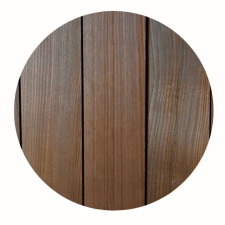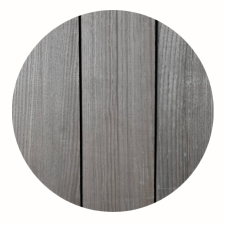Thermally Modified Cladding
Heated above 210 degrees within a vacuum, our thermally modified timber captures the very best of stability and durability. With increased resistance to rot or decay and able to withstand the harshest of winters, it’s perfect for cladding, decking or internally for saunas. Ours is produced sustainably, with energy efficient machinery and the whole process is chemical-free, making it the perfect choice for your next project.
Request a quote
Branching out with Thermally Modified Hardwood
Thermally Modified Hardwood Timber – Durable, Natural, Resilient, and British.
As dedicated advocates of British timber since 1979, we are excited to offer our valued customers this versatile, time tested product using ‘Grown in Britain’ certified wood. Globally renowned for its quality, durability and versatility, Thermally Modified Hardwood Timber opens up new possibilities for your cladding, decking, flooring and furniture needs with unrivalled stability.
See how our thermally modified timber weathers in just 6 months


Thermally Modified Cladding Applications
Our Thermally Modified Cladding Specification
Experience the unmatched durability of our Thermally Modified Ash timber, meticulously crafted to withstand the test of time and harshest British weather. Carefully produced using a globally renowned Thermo Vacuum System from WDE Masspell, our timber is heated to extremely high temperatures in a vacuum atmosphere, with no chemical additives.
This chemical-free process modifies the timbers’ characteristics on a cellular level to enhance durability and stability, ensuring excellent performance even exposed to the elements. The thermal modification process transforms the timber’s resistance to decay, rot and insect damage, ensuring long lasting performance up to 60 years.
Rest assured, as the UK’s largest and most energy-efficient Thermally Modified Ash plant, the production process is 100% eco-friendly. Our Hardwood Timber is fully traceable, locally sourced and carefully transformed from tree to board in our family-run yard in Devon. All UK Hardwoods products are certified ‘Grown in Britain’, allowing customers to support British forestry and local industries with pride.
- Thickness of 18-21mm planed or unplanned at 28mm
- Finished widths 70mm / 95mm / 120mm / 145mm
- Varied lengths 0.9 mt – 4.5 mt
- Available in TG&V, Square Edge, Shadow Gap & other profiles available
- No treatment necessary
- Natural and toxin-free
- Rich chocolate-brown hues with a strong grain pattern, accented by occasional knots. This will beautifully silver with weathering.
- Handle with care during installation
- Less odour than other modified timbers so can be used internally
- Nationwide delivery
Download our Thermally Modified Cladding Brochure
Opening up new possibilities for flooring, cladding and furniture needs, download our brochure to find out the properties and uses of our thermally modified timber.

Thermally Modified Cladding Features

Species
Our Thermally Modified Cladding is created using Ash.

Weathering
Rich chocolate brown hues turn to a silver over time.

Chemical Free
Completely chemical free process.

Paint Coating
No need to paint or treat.

Sustainability
Most energy efficient thermal modification plant in the UK.

Origin
Sourced from certified Woodland Trusts and Estates.

Appearance
Unique grain pattern with minimal knots.

Stability
Super stable due to its hydrophobic nature.

Surface Finishes
Rough sawn or planed.

Application
Can be used for cladding, decking, flooring, boats, yachts or jetties.

Durability
Lasts up to 60 years.

Density
670-700 kg/m³

Secret Fixing
Sleek finish with no visible fixtures.
Our Thermally Modified Cladding Profiles
Able to be tailored and shaped to your specific needs, we have many different profile types available to suit all styles, projects and budgets. Chat to our team to find out more.
UKHW 1

UKHW 2

UKHW 3

UKHW 4

UKHW 5

UKHW 6

UKHW 7

Not sure what you need?
Thermally Modified Cladding FAQs
What timber can be Thermally Modified by UK Hardwoods?
Currently we use Ash to creator Thermally Modified Timber with the view to expand to Poplar in the near future as well as other British Timbers
How does Thermally Modified Ash compare to Green Oak or Green Chestnut Cladding?
Thermally Modified Timber offers unparalleled stability, maintaining minimal expansion and contraction in fluctuating climates. Its superior durability extends the lifespan of your property’s exterior and offers a uniform appearance and refined finish suitable for high quality timber projects.
Do I need to treat Thermally Modified Timber?
Thermally Modified Timber offers a low-maintenance solution that combines elegant design with enhanced durability, as you do not need to treat with an oil. It’s best to let it weather naturally and evenly.
How carefully do I need to handle the Thermally Modified Timber on installation?
We advise pre drilling and using stainless steel fixings. When heated to these temperatures the timber can be more brittle than expected and so please handle with care.
Can I have set lengths and widths?
On request and through conversation with us, we can accommodate your design brief.
How long will Thermally Modified Timber last?
The lifespan when occasionally wet is 60 years and frequently wet is said to be 30 years (above ground use only)
What is the EN350-2 Very Durable. Class 1 (Above ground use only) standard?
This is a European standard that provides guidelines on the natural durability of wood and wood-based products against biological decay (such as fungi, insects, and marine borers). It categorises wood into different classes based on how resistant they are to decay.
Click here to find out more: Durability Classifications
What is the Grade BS1186-3 Class 1 / EN942:2007 J10 standard?
This relates to the grading and quality standards for timber used in joinery and other fine woodworking applications.
Click here to find out more: Quality Standards
What are the fire standards of thermally modified ash timber?
Thermally modified wood generally does not have enhanced fire-retardant properties compared to untreated wood. For higher fire safety standards, additional fire- retardant treatments are required to meet stricter building regulations.
Click here to find out more: Fire Regulations
Ready for a quote?









